
|

|
|
Home Site Search Contact Us Subscribe
|
|
One-on-One: "Architecture is the Construction of a New World": Interview with Nikita Yaveyn The Russian architect talks about creative freedom (and sometimes lack thereof), wooden architecture, and what St. Petersburg might look like in 50 years. By Vladimir Belogolovsky August 25, 2016 Editor’s note: This is Vladimir Belogolovsky’s 11th in a series of one-on-one interviews with architects from around the world; links to previous Q&As are at the end of this interview.
Nikita Yaveyn is a leading architect based in St. Petersburg, Russia. He was born in 1954, and graduated from Leningrad Engineering and Construction Institute (known today as St. Petersburg State University of Architecture and Civil Engineering) in 1977. He started his practice, Studio 44, in 1990. From 1994 to 2003, the architect headed the Committee on State Control, Use and Protection of Historical and Cultural Landmarks of St. Petersburg. His well-published works – including the transformation of the General Staff Building into the new galleries for the State Hermitage Museum (2007-14), and a new building for the Boris Eifman Dance Academy (2008-12) – in his hometown, may be indicative of his strict Modernist approach to architecture. Yet, his broad range of projects reveals his many interests – particularly in finding the specific architecture for each place and culture, and a focus on reviving traditional wood architecture. Examples range from sculptural complexes in Astana and a futuristic high-tech train station in Sochi, to the Tomsk Museum of Science and Technology. Yaveyn also teaches at the Repin State Institute of Painting, Sculpture and Architecture in St. Petersburg. This interview took place at the architect’s 150-person studio.
Vladimir Belogolovsky: Your father was an architect and your older brother is an architect. Would you say that your professional choice was inevitable?
Nikita Yaveyn: I think so. My father was very charismatic and he worked a lot at home. That’s why, ever since I can remember, I wanted to be an architect. What is fascinating is that in my case, the inevitability of my professional choice coincided with my natural predisposition. The idea of a son continuing the pursuit of the father who may not have realized some of his professional ambitions also played a role.
VB: You work mostly in St. Petersburg, but also, on occasion, in Moscow. Are they two distinctive architecture schools to speak of?
NY: There were always differences and they remain today. But they are becoming less pronounced and less noticeable.
VB: Then could you talk about certain features that are characteristic of architectural approaches here in St. Petersburg?
NY: These are things such as well-established internal discipline, a fear of making a sudden, inappropriate gesture. Our architecture is restrained; our projects always express a tremendous reverence toward the surrounding context. The ideology of the St. Petersburg school lies in the fact that harmony of urban totality is far more important than singular expressions of particular buildings. Today, this approach is reinforced by very conservative views of the city bureaucrats who are vigilant in their devotion to preserve the historical fabric. For sure, our architecture is the most conservative in the country.
VB: In other words, local architects have very limited freedom for creativity.
NY: You can say that. Not only do our architects have less freedom, but they also need to do more coordination with the local bureaucrats. And, if in Moscow there is some flexibility, here everything is much tougher and uncompromising.
VB: In 2007, there was an international competition held in St. Petersburg to build a 400-meter tall tower for Gazprom. What do you think about building such supertall structures in what is essentially a horizontal city? What do you think about the fact that not a single Russian architect was invited to participate?
NY: It was a disaster. I was one of the organizers of protests against that competition and the whole idea of building anything tall here. The Gazprom project is the manifestation of nouveau riche behavior in the worst way. I consider this project a subversive action in relation to our city. After numerous protests, the site was moved from the city center to the outskirts; now, it is being built in the Lakhta neighborhood on the shore of the Gulf of Finland. And about not inviting any Russian architects to take part in that completion: I am now glad they didn’t because it only strengthens my position in this matter.
VB: Would you say that the idea of building anything tall in this city is a mistake in principle? Or do you admit it as a possibility?
NY: There are two types of skyscrapers. Economically viable skyscrapers appear in places where very expensive land values make such projects highly profitable. Then there are symbolic skyscrapers. They express the ambitions of their owners and attract attention as advertisement. Here, we have the latter case. We could easily live without such projects.
VB: What kind of contemporary architecture do you feel closer to? Where do you derive your inspiration?
NY: I like regional architecture. For example, I like the architecture in Colombia and Sri-Lanka. I am driven to places where a “different” kind of architecture takes place. I am interested in architecture that occurs naturally from local roots, out of a specific place. Such architecture has things not simply made up, but naturally grown and subsequential. Today, the era of original masters with their individualist aesthetics is over.
VB: So you think that original architecture with its distinguished, personalized hand and voice is coming to an end.
NY: It is not only my opinion. From what I observe, everyone is coming to that realization. This kind of architecture is now in the past. In any case, it is irrelevant.
VB: What about, let’s say, your “voice”? Is it no more? There must be something out there, no?
NY: I like to focus on other things. I am more interested in exploring regional origins based on the history of a particular place and culture.
VB: Are you saying that every time you work on a project in various regions, your architecture changes beyond recognition? Your architecture is always different, and you are not interested in projecting your identity on a particular place, right?
NY: In any event, our competition victories in Kazakhstan and other places are based on our position to seriously examine local culture. Our solutions are based on rethinking the local traditions on the basis of our own national experience; for example, going to our Constructivists roots. Such an approach makes architecture much richer.
VB: What words would you use to describe your architecture and projects? What is you architecture about?
NY: Any architecture is a whole world. Words can only oversimplify it.
VB: Still, what words are close to what you do as an architect?
NY: Constructing, inventing. And inventing not from scratch, but based on specific circumstances.
VB: But an invention means forming or engineering something new, something that did not exist before.
NY: Not necessarily. I am talking about creating a sort of construction, an image that fits the purpose, various requirements, local conditions, and place.
VB: I recently talked to Moscow architect Jury Grigoryan. Responding to my question about the meaning of his architecture, he said, “For me the meaning and goal of architecture is in creating history, and then inventing a form, local and particular.” Do you agree?
NY: Not entirely. I like Grigoryan’s architecture, but he is more about form making. A form in itself is not interesting to me.
VB: Then what is interesting to you?
NY: Constructing a new world. Inventing a whole world – but a world that would be understood and familiar. You know, it is not hard to build a house in the form of a sphere, but it is hard to make it integral and harmonious within and in relation to the environment around it. In other words, a form is always a result, an answer to a specific challenge. An invented form should not dictate a particular solution.
VB: Still, do you aim for inventing a kind of architecture about which you could say – this is mine?
NY: Not consciously. But I am told that my architecture is different, and therefore it is recognizable. Very well. But I don’t think that my projects reveal their author.
VB: You wouldn’t say that each new project continues the preceding one? They tend to be all different, right?
NY: I would say that I have about 10 themes that have been developing in one way or another. But they are not successive. I would describe my architecture as a tree. It consists of many branches. Sometimes more attention is given to one branch. Then this branch dries up for five years. Then some moisture activates another branch and it reawakens.
VB: Do these branches have names?
NY: Let’s call one of my favorite themes this way – “To reassemble.” There is a set of certain methods for disassembling established prototypes of buildings, which then get reassembled into something new. And sometimes in such exercises you are left with parts that may not be used in the current project, so they are put aside. Then they are recycled in other projects. In other words, you may come across some ideas that you may not use right away, so they are stored for a while. The architect should rely on a good memory to pull out appropriate ideas in the right moment. And when you run out of all the parts, you are forced to invent something new. [Laughs.]
VB: Tell me about your projects in Kazakhstan. How do you approach them?
NY: All our projects are in Astana, where architecture is very different from contemporary architecture in Kazakhstan in general. We’ve designed six projects there. Four were won in competitions. The Palace of Schoolchildren and the Palace of Youth were built. Both complexes are cities within a city with dozens of functions. Every competition there has a jury, but President Nursultan Nazarbayev makes the final decision.
VB: Does he understand architecture so well?
NY: Based on the fact that he already chose four of my projects, he has a good taste. [Laughs.]
VB: It was said about your Museum of Science and Technology in Tomsk: “It reinterprets and develops the tradition of domestic architecture in Tomsk.” Could you talk about this project?
NY: Speaking of distinctive national architecture in Russia, we have to mention wooden architecture. I am sure that every Russian has an understanding about how to build a wooden hut. In Tomsk, there are more surviving examples of wooden architecture than anywhere else in the country. To this day, 70% of the historical city center consists of two- and three-story wooden houses. Wooden architecture remains a living tradition for many regions in Russia. And it is wooden architecture that continues to carry a distinctive way of form making and detailing. Starting with structures explored at late 19th- and early 20th-century trade fairs and exhibitions, architects reanimated wooden construction and brought it to a new professional level. The clearest manifestation of this was the first All-Russian Agricultural and Domestic Industry Exhibition of 1923 in Moscow, for which there were built many ingenious pavilions by Ivan Zholtovsky and Konstantin Melnikov, among others. These wooden pavilions became one of the highest achievements of Russian avant-garde, but may not be as celebrated as other projects by the Constructivists.
VB: In other words, your museum in Tomsk revives Russian wooden architecture traditions.
NY: Absolutely. More so, there are practically no contemporary structures built of wood here because, since the Soviet times, we have very conservative fire safety codes that forbid the use of wood in the construction of large public buildings. Architects constantly have to fight these archaic requirements. In contrast, our museum loudly declares the widest possible use of wood in contemporary architecture. Rising over the two-story pitched roof structure are five archetypal towers with hexagon, cross, circle, square, and octagon in their plans – all to be built in wood.
VB: St. Petersburg’s historical center has long been defined. Nevertheless, how do you envision your city, let’s say, in 50 years? Do you think it will go through major changes, or will it tend to preserve itself the way we know it today?
NY: Slowly, some existing buildings are being replaced by new ones. But I have to admit that over the last couple of decades, the city center did not become more convenient for tourists and residents. On the contrary, the city’s connectivity was significantly diminished due to the closure of many interconnected residential courtyards; this step decreased the area of public spaces in the historical center. The issue of transformation of the city into something more contemporary and convenient will come up eventually, and it will have to be dealt with.
VB: If some historical buildings do gradually disappear, can you imagine that their places will be taken by frankly modern, 21st-century structures?
NY: I don’t think such drastic transformation is possible here. Most likely, old buildings will be replaced by something quite close in appearance to the originals. Or new buildings will be hiding behind historical façades. Today, historic preservation is very powerful in St. Petersburg. That’s why it is more likely that we will see an increase in connectivity within the historical fabric, not radical replacement of old architecture with new. The most important thing here is to complement the existing urban spaces with a whole system of new public spaces along minor streets and courtyards by tying it all together. There are many possibilities to add density to the city within its current territory, and there is absolutely no need for building new, grandiose projects on the scale of the Gazprom tower – not in the center and not on the outskirts.
Vladimir Belogolovsky, founder of the New York City-based non-profit Intercontinental Curatorial Project, curates architectural exhibitions worldwide, and writes for Arquitectura Viva (Madrid) and SPEECH (Berlin) magazines. Trained as an architect at Cooper Union, he is the author of Conversations with Peter Eisenman: The Evolution of Architectural Style (DOM, 2016), Conversations with Architects in the Age of Celebrity (DOM, 2015), Harry Seidler: LifeWork (Rizzoli, 2014), Felix Novikov (DOM, 2013; Tatlin, 2009), Soviet Modernism: 1955-1985 (Tatlin, 2010), and Green House (Tatlin, 2009). His conceptual installation “City of Ideas: Architects’ Voices & Visions” premiered at the University of Sydney in July 2016, and will be shown at the Chicago Design Museum October 22, 2016 - February 25, 2017, before continuing its world tour.
More by Belogolovsky:
One-on-One: A Cult of Objectivity: Interview with Massimo
Vignelli
One-on-One: Architecture is not exactly global: Interview
with Orlando Garcia
One-on-One: Revolution in Architecture: Interview with
Gregg Pasquarelli, SHoP Architects
"Harry Seidler: Architecture, Art and Collaborative Design" A new traveling exhibition celebrates the 90th anniversary of the birth of Harry Seidler, the leading Australian architect of the 20th century who followed his convictions and vision.
Colombia: Transformed / Architecture = Politics The curators of the exhibition making its world debut in Chicago this week throw the spotlight on five Colombian architects who leverage brick, concrete, and glass forms to improve the lives of ordinary people.
One-on-One: We architects are politicians: Interview with Giancarlo Mazzanti "Now is the time to think of how architecture can change the world. We architects can assume that role and make a real difference in how people live and behave."
One-on-One: Architecture that leads to a point: Interview with Daniel Libeskind "Every building, every city should have a story."
One-on-One: Architecture of Emotion and Place: Interview with Bartholomew Voorsanger, FAIA, MAIBC The architect's aspiration to create expressive, dynamic spaces is absolutely the key to his work.
One-on-One: Architecture as a Social Instrument: Interview with Bjarke Ingels of BIG It is not for nothing that this young architect is referred to as the "Yes Man" with a willingness - and ability - to please just about everyone.
One-on-One: Putting Colors Together: An Interview with Will Alsop For Alsop, it is the act of painting, the state of losing control - its imprecision and intuitiveness - that best define his initial vague intentions - and what ultimately brings him close to the mystery of inventing new architecture.
One-on-One: The Art of Ennobling Communities: Interview with Sara Caples and Everardo Jefferson These architects have proven time and time again that architecture can transform reality and change attitudes.
One on One: Elusive Architecture: Interview with Kengo Kuma "I want to create a condition that is as vague and ambiguous as drifting particles. The closest thing to such a condition is a rainbow."
|
(click on pictures to enlarge)  ęStudio 44 Architects Tomsk Museum of Science and Technology, Tomsk, Russia, 2015 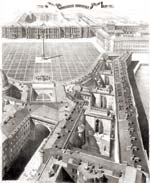 ęStudio 44 Architects State Hermitage Museum in the General Staff Building, Saint Petersburg, Russia, 2002-2014 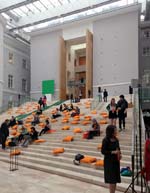 ęStudio 44 Architects General Staff Building, State Hermitage Museum 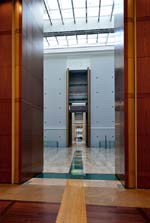 ęStudio 44 Architects General Staff Building, State Hermitage Museum 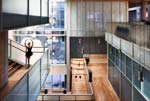 ęStudio 44 Architects Boris Eifman Dance Academy, Saint Petersburg, Russia, 2008-2013  ęStudio 44 Architects St. Petersburg State University Graduate School of Management cafeteria, Saint Petersburg, Russia, 2009; this is one of several Studio 44 projects for the campus on the former palace grounds of the historic Mikhailovskaya Dacha.  ęStudio 44 Architects Olympic Park railway station, Sochi, Russia, 2010-2013 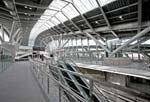 ęStudio 44 Architects Olympic Park railway station  ęStudio 44 Architects International competition winning proposal for the Palace of Schoolchildren, Astana, Kazakhstan, 2008-2011  ęStudio 44 Architects Palace of Schoolchildren  ęStudio 44 Architects Palace of Schoolchildren 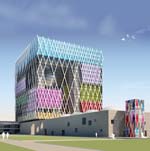 ęStudio 44 Architects International competition winning proposal for Zhastar Palace, Astana, Kazakhstan, 2013  ęStudio 44 Architects International competition winning proposal for the main railway stationin Astana, Kazakhstan, 2010 |
ę 2016 ArchNewsNow.com